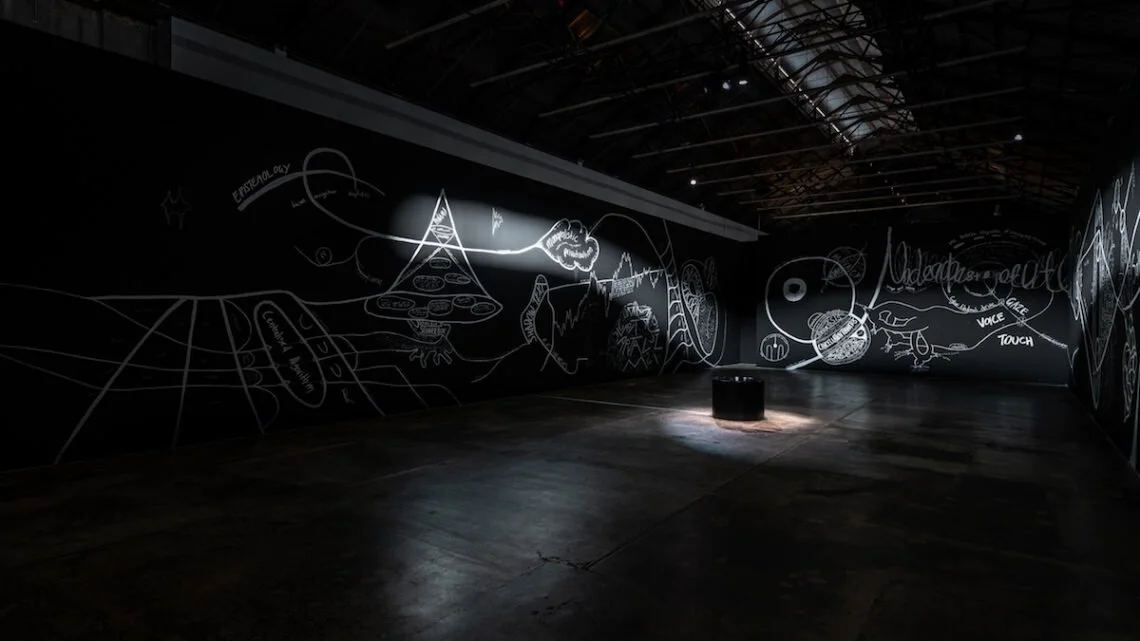In the dark belly of a boat, two bodies push makeshift prosthetics to their limits. A collection of utilitarian objects is strewn across the floor: this assortment of tubes, pumps, ropes, and bellows feels at once vaguely medical, industrial, and medieval.
Giselle Stanborough’s Cinopticon was relevant well before the current pandemic crisis. But as our personal and professional lives are moving online rapidly and more comprehensively than ever, Stanborough’s research takes on a kind of chilling urgency.
Rosie Deacon first presented a version of Fashion Forest Seduction in Launceston in January 2019. In a nondescript annex of the local Workers’ Club, up a flight of steel fire stairs, a door opened onto an extravagance of colour, texture and sound.
As we mill around under the unmistakable brutalist ceiling of the Art Gallery of New South Wales (AGNSW) foyer, there is a collective sense of anticipation. The audience instinctively forms a rectangular perimeter, but the distinction between performers and spectators remains immaterial; there is no designated platform or clear physical barrier.
In Velveteen, Ali Noble builds on a vocabulary of shapes, colours and materials that has been evolving through more than a decade of practice. This language is arcane and hieroglyphic, but its letterforms are playful: arabesques, crescents, vaults or aqueducts, rounded scallops like cartoon clouds.
Justene Williams was on the road to Sydney when we first spoke ahead of her forthcoming solo exhibition, Project Dead Empathy, at Sarah Cottier Gallery. The back of the car was full with the stuff that comprises her anarchic installations, and I imagined over-long mannequin arms stretching around headrests as we spoke.
The first thing I notice when I look at art is almost always the materials: the stuff that things are made of. The thingness of things. I look for whether materials are made to disappear in service of an image or a narrative, or whether they tell a story through their own texture and heft, through familiar or strange configurations.
Compared to painting and sculpture, video art is new, but since the 1960s it has been taken in a number of distinct directions. It is documentation of live performances and public dissemination of private ones; it is moving photography, stop-motion wizardry, protracted documentary and minimalist arthouse.
Wood smoke floats gently over the harbour from a far corner of Cockatoo Island. Under an open-sided shelter, fire is contained in steel drums. Perched above them on a metal lattice are ceramic cups of varying size, their sides licked brown and black by the flames.
Shortly after I enter the space, two men walk in arm in arm. One is tracing a path with a white cane while the other is talking him through the exhibition. The man explaining the art is in his forties or fifties, and talks like someone who sees exhibitions occasionally, but is not accustomed to putting them into words.
If you look at one of Steaphan Paton’s works and can’t quite imagine how it was made, that’s good. Don’t ask, just enjoy not knowing and embrace the theatre of the object. To date, Paton’s practice encompassed a wide range of materials and processes, but fundamentally, he considers all his works to be forms of sculpture.
The lead image on QAGOMA’s website for Curious Affection is a portrait of the artist, Patricia Piccinini, next to one of her sculptures. The sculpted faces of a woman and the fleshy, ridge-backed child-creature she cradles could almost be real. When contrasted with the artist’s body, though, the blankness of their eyes and a slight waxiness of flesh give them away.
We begin at the end: a funeral. Well-dressed men and women sob, tears running down their cheeks. The camera pans across an open coffin, over the face of a young man. The large church is claustrophobic with pale blooms.
“I met a man who told me he loved my ceramic bin. It took him back to his childhood when him and his friend used to tip them over and use them as cricket wickets. I was tempted to tell him about how I watched a man take a shit in one once in an open field.”
Trained as an artist and also in information management as an archivist, Greenhalgh is a digital scavenger: he samples the archive, reviving fragments from obscurity and tending to them with hours upon hours of tedious rotoscoping: tracing outlines at 24 frames per second.









